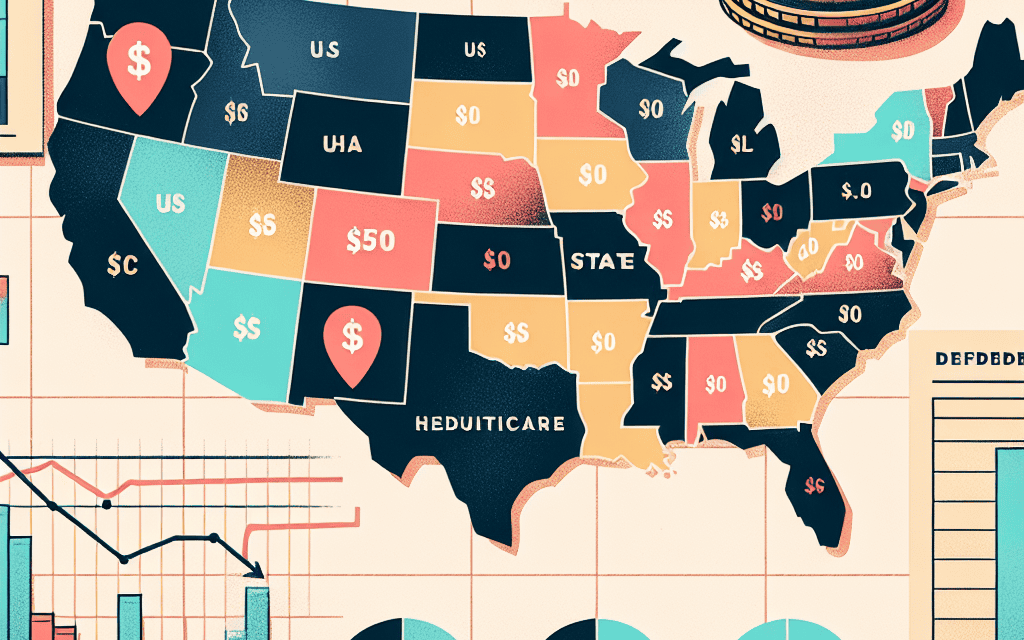Potential Economic Impact of Reduced ACA Subsidies on State Economies: A Report
The Affordable Care Act (ACA), enacted in 2010, has significantly transformed the landscape of healthcare in the United States. One of its most critical components is the provision of subsidies to help low- and middle-income individuals afford health insurance. However, recent discussions around reducing these subsidies have raised concerns about the potential economic impact on state economies. This report delves into the multifaceted implications of reduced ACA subsidies, exploring how such changes could affect healthcare access, state budgets, employment, and overall economic stability.
1. Understanding ACA Subsidies and Their Role in Healthcare Access
To comprehend the potential economic impact of reduced ACA subsidies, it is essential to first understand what these subsidies are and how they function within the healthcare system. ACA subsidies are designed to lower the cost of health insurance premiums for individuals and families who earn between 100% and 400% of the federal poverty level (FPL). These subsidies are crucial for making healthcare accessible to millions of Americans.
Subsidies come in two forms: premium tax credits and cost-sharing reductions. Premium tax credits directly reduce the monthly premium costs for eligible individuals, while cost-sharing reductions lower out-of-pocket expenses like deductibles and copayments. Together, these subsidies have played a vital role in increasing insurance coverage rates across the country.
According to the U.S. Census Bureau, the uninsured rate dropped from 16% in 2010 to approximately 9% in 2020, largely due to the ACA and its subsidies. This increase in coverage has not only improved individual health outcomes but has also had broader implications for state economies.
Impact on Healthcare Access
Reduced subsidies would likely lead to increased premiums and out-of-pocket costs for many individuals, resulting in a decline in healthcare access. This decline could manifest in several ways:
- Increased Uninsured Rates: As premiums rise, many individuals may find health insurance unaffordable, leading to a potential increase in the uninsured rate. States with higher uninsured rates often face greater public health challenges, as uninsured individuals are less likely to seek preventive care.
- Delayed Medical Care: Individuals who cannot afford insurance may delay seeking medical care until their conditions worsen, leading to higher healthcare costs in the long run. This can strain state healthcare systems and increase emergency room visits.
- Health Disparities: Reduced access to affordable healthcare can exacerbate existing health disparities, particularly among low-income and minority populations. This can lead to poorer health outcomes and increased healthcare costs for states.
In summary, the role of ACA subsidies in facilitating healthcare access cannot be overstated. Reducing these subsidies could reverse the progress made in expanding coverage and improving health outcomes, ultimately impacting state economies negatively.
2. Economic Consequences of Increased Uninsured Rates
The potential increase in uninsured rates due to reduced ACA subsidies could have far-reaching economic consequences for state economies. Uninsured individuals often rely on emergency services for their healthcare needs, which can lead to significant financial burdens on state healthcare systems.
Financial Strain on State Healthcare Systems
When individuals lack insurance, they are more likely to seek care in emergency rooms, which are required by law to treat all patients regardless of their ability to pay. This can lead to several economic challenges:
- Increased Healthcare Costs: Emergency care is significantly more expensive than preventive care. States may face increased costs associated with treating uninsured patients, which can strain public hospitals and healthcare facilities.
- Higher Taxes: To cover the costs of uncompensated care, states may need to increase taxes or reallocate funds from other essential services, such as education and infrastructure.
- Impact on Local Economies: Hospitals and healthcare providers are significant employers in many states. Increased financial strain on these institutions can lead to job losses, reduced wages, and decreased economic activity in local communities.
For example, a study by the American Hospital Association found that uncompensated care costs for hospitals reached $41.6 billion in 2019. If ACA subsidies are reduced, these costs could rise, further burdening state economies.
Long-Term Economic Implications
The long-term economic implications of increased uninsured rates can be profound. A healthier population contributes to a more productive workforce, while a sicker population can lead to decreased productivity and increased absenteeism. This can create a vicious cycle where economic growth is stunted due to poor health outcomes.
Moreover, states with higher uninsured rates may struggle to attract businesses and investments. Companies often consider the health of the workforce when deciding where to locate, and a lack of access to affordable healthcare can be a deterrent.
In conclusion, the economic consequences of increased uninsured rates due to reduced ACA subsidies are significant. States may face financial strain on their healthcare systems, increased taxes, and long-term challenges to economic growth and stability.
3. The Impact on State Budgets and Fiscal Health
State budgets are intricately linked to healthcare spending, and any changes to ACA subsidies can have immediate and long-term effects on fiscal health. States that expanded Medicaid under the ACA have seen significant financial benefits, but these could be jeopardized by reduced subsidies.
Medicaid Expansion and State Budgets
Many states opted to expand Medicaid under the ACA, which allowed them to cover more low-income individuals. This expansion has been largely funded by the federal government, with states covering a smaller percentage of costs. However, if ACA subsidies are reduced, states may face increased pressure to cover uninsured individuals through Medicaid.
- Increased Enrollment: A reduction in subsidies could lead to higher enrollment in Medicaid programs as individuals seek affordable coverage. This could strain state budgets, particularly if federal funding is not adjusted accordingly.
- Budget Reallocations: States may need to reallocate funds from other essential services to cover increased Medicaid costs, impacting education, transportation, and public safety.
- Long-Term Fiscal Challenges: If states are forced to cover more uninsured individuals, they may face long-term fiscal challenges that could hinder their ability to invest in infrastructure and economic development.
For instance, a report from the Kaiser Family Foundation indicated that states that expanded Medicaid saw a significant reduction in uncompensated care costs, which helped improve their overall fiscal health. Reducing ACA subsidies could reverse these gains, leading to increased financial burdens on state budgets.
Potential Solutions and Mitigation Strategies
To mitigate the potential negative impacts on state budgets, policymakers may need to consider several strategies:
- Enhancing State Funding: States could explore options to enhance funding for Medicaid programs, such as increasing taxes on high-income earners or implementing new revenue-generating measures.
- Encouraging Preventive Care: Investing in preventive care initiatives can help reduce long-term healthcare costs by keeping individuals healthier and reducing the need for expensive emergency care.
- Collaboration with Federal Government: States can work with the federal government to seek additional funding or flexibility in Medicaid programs to accommodate increased enrollment.
In summary, the impact of reduced ACA subsidies on state budgets and fiscal health is a critical concern. States may face increased costs associated with Medicaid enrollment, necessitating careful planning and strategic decision-making to maintain fiscal stability.
4. Employment Implications of Reduced ACA Subsidies
The relationship between healthcare access and employment is complex. Reduced ACA subsidies could have significant implications for employment rates, job creation, and workforce stability across states.
Job Losses in the Healthcare Sector
The healthcare sector is one of the largest employers in the United States, and any changes to ACA subsidies could lead to job losses in this critical industry. As hospitals and healthcare providers face increased financial strain due to rising uncompensated care costs, they may be forced to make difficult decisions regarding staffing.
- Layoffs and Reduced Hiring: Financial pressures may lead to layoffs or a freeze on hiring, impacting thousands of healthcare workers. This can have a ripple effect on local economies, as healthcare jobs often support other sectors.
- Wage Stagnation: Increased financial strain on healthcare providers may also lead to wage stagnation or reductions, impacting the overall economic well-being of healthcare workers.
- Impact on Related Industries: Job losses in healthcare can affect related industries, such as pharmaceuticals, medical equipment manufacturing, and health technology, leading to broader economic repercussions.
Effects on Workforce Productivity
Access to affordable healthcare is crucial for maintaining a healthy workforce. Reduced ACA subsidies could lead to increased uninsured rates, resulting in a less healthy population and decreased workforce productivity.
- Increased Absenteeism: Employees without health insurance may delay seeking medical care, leading to more frequent illnesses and increased absenteeism. This can impact productivity and overall economic output.
- Decreased Job Satisfaction: Employees who struggle with healthcare costs may experience increased stress and decreased job satisfaction, leading to higher turnover rates and associated costs for employers.
- Long-Term Health Consequences: A less healthy workforce can lead to long-term health consequences, increasing healthcare costs for employers and potentially impacting their bottom line.
In conclusion, the employment implications of reduced ACA subsidies are significant. Job losses in the healthcare sector and decreased workforce productivity can have far-reaching effects on state economies, necessitating careful consideration of the potential consequences of subsidy reductions.
5. Case Studies: States Facing the Consequences of Reduced ACA Subsidies
To better understand the potential economic impact of reduced ACA subsidies, it is helpful to examine case studies of states that have experienced similar challenges. These examples can provide valuable insights into the broader implications for state economies.
Case Study 1: Texas
Texas has one of the highest uninsured rates in the country, with approximately 18% of its population lacking health insurance. The state has not expanded Medicaid under the ACA, leading to significant challenges in healthcare access and economic stability.
- Healthcare Access Challenges: The lack of Medicaid expansion has resulted in millions of Texans remaining uninsured, leading to increased reliance on emergency services and higher healthcare costs for the state.
- Economic Consequences: The high uninsured rate has deterred businesses from relocating to Texas, impacting job creation and economic growth. Employers often consider healthcare access when making location decisions.
- Public Health Implications: The high uninsured rate has contributed to poorer health outcomes in Texas, leading to increased healthcare costs and economic burdens on the state.
Case Study 2: California
California expanded Medicaid under the ACA and has seen significant improvements in healthcare access and economic stability. However, discussions around reducing ACA subsidies could threaten these gains.
- Improved Healthcare Access: California’s Medicaid expansion has led to a significant reduction in the uninsured rate, improving health outcomes and reducing uncompensated care costs for hospitals.
- Economic Growth: The state has experienced economic growth as a result of increased healthcare access, attracting businesses and investments that rely on a healthy workforce.
- Potential Risks: If ACA subsidies are reduced, California could face increased enrollment in Medicaid, straining state budgets and potentially reversing the progress made in healthcare access.
These case studies illustrate the complex relationship between ACA subsidies, healthcare access, and state economies. The potential consequences of reduced subsidies could vary significantly based on each state’s unique circumstances and policy decisions.
Conclusion
The potential economic impact of reduced ACA subsidies on state economies is a multifaceted issue that warrants careful consideration. As this report has outlined, the implications extend beyond healthcare access to encompass state budgets, employment, and overall economic stability.
Key takeaways from this report include:
- The critical role of ACA subsidies in facilitating healthcare access and reducing uninsured rates.
- The financial strain on state healthcare systems that could result from increased uninsured rates.
- The potential challenges to state budgets and fiscal health due to rising Medicaid enrollment and uncompensated care costs.
- The employment implications of reduced ACA subsidies, including job losses in the healthcare sector and decreased workforce productivity.
- Case studies from states like Texas and California that highlight the diverse impacts of ACA subsidy changes on state economies.
In conclusion, policymakers must carefully weigh the potential consequences of reducing ACA subsidies, considering both the immediate and long-term effects on state economies. Ensuring access to affordable healthcare is not only a moral imperative but also a critical component of economic stability and growth.





